Full name stadiummk Field size 105 m x 68 m Capacity 30,500 Team Milton Keynes Dons F.C. | Owner Inter MK Surface Desso GrassMaster Opened 29 November 2007 Architecture firm Populous | |
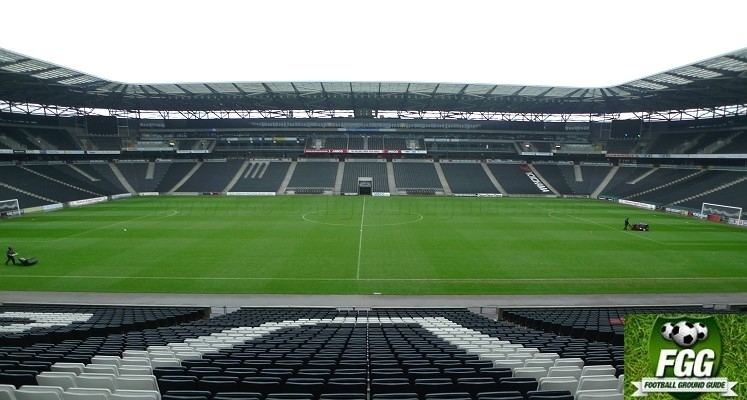 | ||
Location Denbigh, Milton Keynes, England Record attendance 30,048 Rugby World Cup 2015 Fiji vs Uruguay Similar Sandy Park, Kingsholm Stadium, Kassam Stadium, Falmer Stadium, Madejski Stadium | ||
Vlog 4 mk dons vs leeds trip to stadium mk
Stadium mk (initially named stadium:mk, stylistically stadiummk, and also known locally as "Denbigh Stadium") is a football ground in the Denbigh district of Milton Keynes, Buckinghamshire, England. Designed by Populous, it is the home ground of Football League One side Milton Keynes Dons F.C.
Contents
- Vlog 4 mk dons vs leeds trip to stadium mk
- Milton Keynes Stadium Consortium
- Relocation of Wimbledon FC Milton Keynes Dons FC
- Proposed temporary use by Tottenham Hotspur FC
- Stadium size
- Events
- Naming of stands
- England 2018 World Cup bid
- Premiership
- European Rugby Champions Cup
- Rugby World Cup 2015
- Location
- Localnearby facilities
- Transport
- References
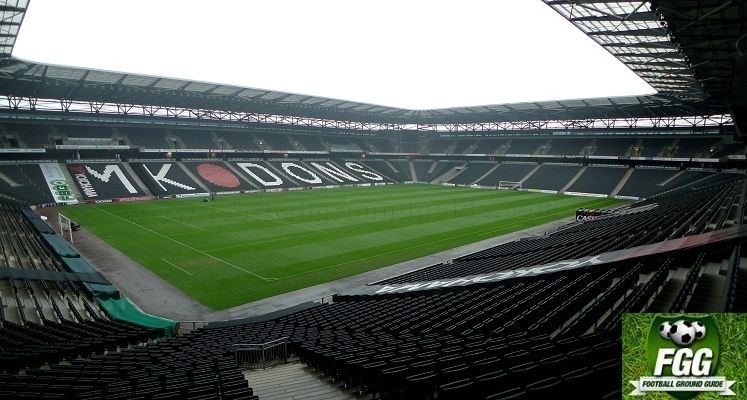
As of May 2015, the stadium has two tiers which hold a capacity of 30,500. Should it be required, there is the option to increase the capacity of the stadium again to 45,000 with the addition of a third tier, hence the high roof. The design will comply with UEFA's Elite Stadium specifications and includes a Desso GrassMaster playing surface.
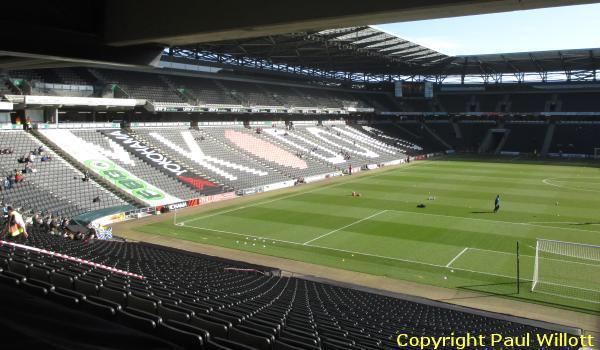
The plans of the complex included an indoor arena, arena:mk, that was to be the home of the Marshall Milton Keynes Lions professional basketball team. However, the retail developments that would have provided enabling funding were deferred due to lack of financing, leaving the Lions without a home. Following the conclusion of the 2011–12 season, the Lions could not secure a venue within Milton Keynes, resulting in a move south to the Copper Box.
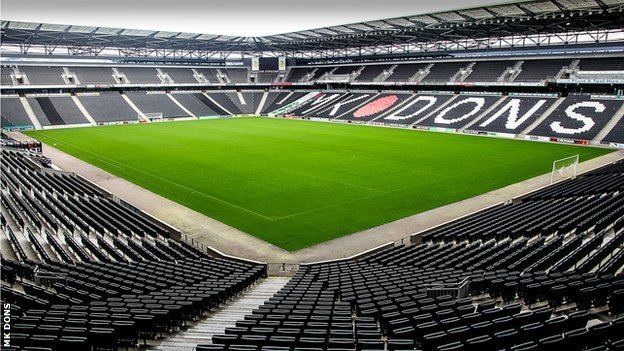
In addition to association football, the stadium occasionally hosts rugby union. The first such occasion was in May 2008, when Saracens (who at the time groundshared with Watford at Vicarage Road) played Bristol at Stadium mk because Watford needed their ground for a Championship play-off. In 2011, Northampton Saints RFC used the ground for their Heineken Cup quarter and semi-final matches because their home ground is too small for major events. The stadium hosted three matches in the 2015 Rugby World Cup.
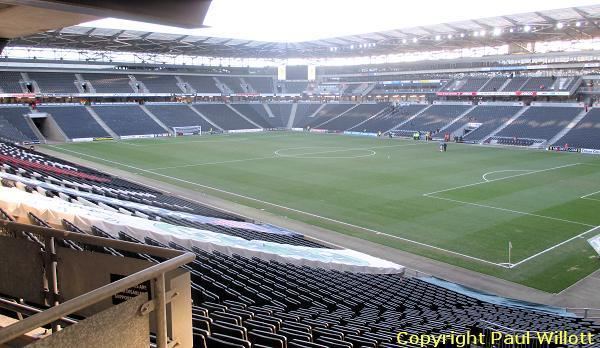
Milton Keynes Stadium Consortium
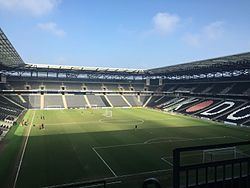
From the first days of Milton Keynes as a new town, designated in 1967, the Milton Keynes Development Corporation (1967–1992) envisaged a stadium capable of accommodating a top-flight football team. What would become Stadium MK was first proposed in 2000 by the Milton Keynes Stadium Consortium or "Stadium MK", led by Pete Winkelman and his company Inter MK Group. This consortium proposed a large development in the southern Milton Keynes district of Denbigh North, including a 30,000-capacity football stadium, a 150,000-square-foot (13,935 m2) Asda hypermarket, an IKEA store, a hotel, a conference centre, and a retail park. The plan to build a ground of this size was complicated by the fact that there was no professional football club in Milton Keynes and that the highest-ranked team in the town, Milton Keynes City—based in Wolverton in northern Milton Keynes, and formerly known as Mercedes-Benz F.C.—played in the then eighth-tier Spartan South Midlands League, four divisions below the Football League. The developers could not justify building such a stadium for a club of this small stature. Rather than wait for MK City or another local team to rise to the professional leagues by promotion, Winkelman resolved to "import" an established League club to use the ground.
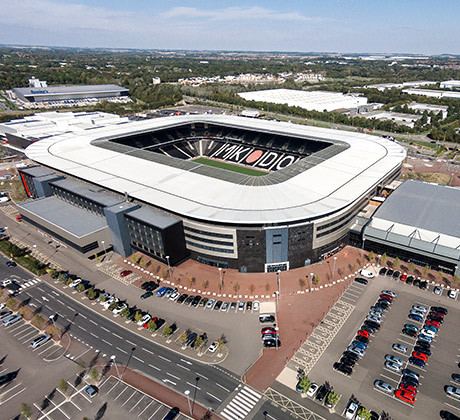
Winkelman, an ex-CBS Records executive and music promoter, had moved to the Milton Keynes area from London in 1993. He attested to a vast untapped fanbase for football in Milton Keynes—a "football frenzy waiting to happen", he said. Critics of this claim pointed to the apparent lack of public interest in Milton Keynes City and the other local non-League clubs, and argued that Milton Keynes residents interested specifically in League football already had ample access with Luton Town, Northampton Town and Rushden & Diamonds all within 25 miles (40 km). In Winkelman's own words, in a 2013 interview, he "didn't have a clue about football" when he was proposing to move a League club from another town—indeed looking back he said "it was that naivety that enabled me to go and do it." He was the only person in Milton Keynes publicly associated with the project; his financial supporters, later revealed to be Asda (a subsidiary of Walmart) and Ikea, were kept strictly anonymous.
Opponents of such a move surmised that the stadium was a "Trojan Horse" included in the blueprint to bypass planning rules, and that although the consortium described the larger development as enabling the construction of the stadium, the reverse was the case—Winkelman's consortium, they claimed, had to have a professional team in place right away to justify the ground so the development could get planning permission. David Conn of The Guardian corroborated this assessment. "The whole project was indeed dependent on Asda and Ikea," Conn summarised in a 2012 article, after interviewing Winkelman. "Having seen the opportunity to build a stadium Milton Keynes lacked, and realised Asda did not have a store in the town, Winkelman acquired options to buy the land from its three owners, including the council. Asda would not have been granted planning permission for a huge out-of-town superstore unless it gave the council the benefit of building the stadium. [A League club] would move up, permission would be granted, then [Winkelman] would exercise the option to buy all the land, sell it to Asda and IKEA for very much more, and the difference would be used to build the stadium." Conn retrospectively described this as the "deal of a lifetime".
Relocation of Wimbledon F.C.; Milton Keynes Dons F.C.
Starting in 2000 the consortium offered this proposition to several Football League clubs, including Luton Town, Crystal Palace, Barnet, Queens Park Rangers, and Wimbledon F.C.. Wimbledon F.C., who had groundshared at Crystal Palace's Selhurst Park ground since 1991, adopted the Milton Keynes plan after the appointment of a new chairman, Charles Koppel, in January 2001. Koppel said that such action was necessary to prevent Wimbledon F.C.'s going out of business. He announced Wimbledon F.C.'s intent to move on 2 August 2001 with a letter to the Football League requesting approval, stating that Wimbledon had already signed an agreement to relocate and "subject to the necessary planning and regulatory consents being obtained" intended to be playing home games at a newly built stadium in Milton Keynes by the start of the 2003–04 season. The proposed move was opposed in most quarters; the League board unanimously rejected Wimbledon's proposed move in August 2001. Koppel appealed against this decision, leading to a Football Association (FA) arbitration hearing and subsequently the appointment of a three-man independent commission by the FA in May 2002 to make a final and binding verdict. The League and FA stated opposition but the commissioners ruled in favour, two to one.
Wimbledon F.C. hoped to move to Milton Keynes immediately, but as the new ground was yet to be built an interim home in the town would have to be found first. The first proposal, to start the 2002–03 season at the National Hockey Stadium in central Milton Keynes, was abandoned because it did not meet Football League stadium criteria. While alternative temporary options were examined—Winkelman suggested converting the National Bowl music venue—Wimbledon F.C. started the season at Selhurst Park and set a target of playing in MK by Christmas 2002. A group of Wimbledon F.C. fans protested by setting up AFC Wimbledon, to which the vast majority of Wimbledon F.C. fans switched allegiance, in June 2002. A temporary stadium in Milton Keynes proved difficult to arrange and Wimbledon F.C. remained in south London at the end of the 2002–03 season. Koppel announced a plan to convert the National Hockey Stadium for football and play there from the start of the 2003–04 season until the new stadium was built.
Wimbledon F.C. entered administration in June 2003. After the club missed a deadline to invest in renovations to the Hockey Stadium, confusion arose as to whether Wimbledon F.C. would move and where they would play if they did. The administrators arranged a return to Selhurst Park. With the move threatened and the club facing liquidation, Winkelman made "the life-defining decision", to quote Conn, "of taking it on himself". He secured funds from his consortium for the administrators to pay the players' wages, keep the club operating, and pay for the necessary renovations for the National Hockey Stadium to host League football. Meanwhile, Milton Keynes City F.C. went out of business before the start of the season following an unsuccessful drive for new directors and investors.
After hosting the first few home matches of the 2003–04 campaign at Selhurst Park, Wimbledon F.C. played their first match in Milton Keynes in September 2003. A company voluntary arrangement was put together in March 2004 under which Winkelman's consortium would take Wimbledon F.C. out of administration, reportedly using a holding company called MK Dons. The Football League threatened to expel the club if the takeover were not completed by 31 July. Winkelman's Inter MK Group brought Wimbledon F.C. out of administration in late June 2004 and concurrently announced changes to its name, badge and colours. The new name was Milton Keynes Dons F.C. (commonly shortened to MK Dons).
Milton Keynes Dons continued to play at the National Hockey Stadium while the development including the new ground was constructed in Denbigh. Asda paid Inter MK £35 million for its section of the site, IKEA £24 million. Ground was broken on the stadium in February 2005. In December 2005 MK Dons set a target of playing at the new ground by January 2007; in February 2007 they revised their proposal to a 22,000-seater stadium ready in July of that year, with provision for expansion to 32,000 (it had originally been intended to seat 30,000). The new ground, Stadium mk, hosted its first match in July 2007. Four months later, on 29 November 2007, it was officially opened by Queen Elizabeth II.
Proposed temporary use by Tottenham Hotspur F.C.
In late 2014, it was reported that Premier League club Tottenham Hotspur were in negotiations with MK Dons over a temporary groundshare at Stadium mk for a season, during renovations at Spurs' White Hart Lane ground. According to press reports, Tottenham proposed to play most home matches in MK and a small number at Wembley Stadium. The idea of playing home matches in Milton Keynes, even temporarily, is largely unpopular with Spurs fans. The Tottenham Hotspur Supporters Trust stated in September 2014 that it would have "serious issues" with such an arrangement. In a London Evening Standard poll of 206 Tottenham fans two months later, 71 (34%) said they would attend home matches at Stadium mk if the club played there temporarily, while 135 (66%) said they would not. The Premier League chief executive Richard Scudamore stated in July 2015 that the Premier League would have no objection to Tottenham groundsharing temporarily—either with MK Dons or with Chelsea at Wembley—but to defend "the integrity of the competition" would not allow Tottenham to play home matches at more than one location in the same season. Two months later, the FA chief executive Martin Glenn indicated that he supported the idea of clubs playing temporarily at Wembley while their grounds were redeveloped.
Stadium size
Initially there were concerns that the size of the stadium may have been too optimistic. Although attendances increased since leaving the National Hockey stadium, the stadium has yet to sell out for Dons' games. The MK Dons average attendance of 10,550 during the 2008–09 League One season remains below half the ground capacity. The MK Dons average home attendance for the first part of the 2009–10 season was ranked 6th out of 24 teams in League One. The average attendance for the 2012–13 season was just 8,612; in the 2013–14 season it was 9,047; in the 2015-16 season it was 13,158.
The record attendance for a football match at Stadium MK was on 31 January 2016 when a crowd of 28,127 attended Milton Keynes Dons' 5–1 defeat in the FA Cup by Chelsea. On 6 October 2015, StadiumMK hosted the rugby World Cup match, Uruguay Vs Fiji and this set the new record attendance to 30,043. On 4 February 2017 a record league attendance of 21,545 was set against Bolton Wanderers in Football League One.
Events
Although Queen Elizabeth II officially opened the stadium in November 2007, it hosted its first game on 18 July 2007, a match against a Chelsea XI, which resulted in a 4–3 win for the home side. Later in July an England Legends XI took on a World Legends XI in a match in memory of the late England footballer Alan Ball.
The stadium was used as a centrepoint for the 40th birthday celebrations of Milton Keynes which took place during 2007.
It has hosted two England under-21 internationals. The first was a 2009 UEFA European Under-21 Championship qualification Group 3 match against Bulgaria’s under-21’s on November 16, 2007. The hosts beat the visitors 2–0 with Mark Noble scoring twice (on the tenth minute and the seventeenth minute) and James Milner scoring on the twenty sixth minute with 20,222 in attendance. The other was an international friendly against Azerbaijan’s under 21’s March 31, 2009. The hosts thrashed the visitors 7–0 with Kieran Gibbs scoring twice and single goals from Michael Mancienne, Craig Gardner and Jack Rodwell as well as own goals from Elcin Sadiqov and Elvin Mammadov with 12,020 in attendance.
The stadium also marked another first on 8 May 2008 when it hosted its first rugby union fixture. Guinness Premiership side Saracens entertained Bristol away from their regular Vicarage Road ground, due to Watford F.C. playing at home in the 2008 Championship play-off semi-final.
On 5 June 2010, the stadium hosted a full international friendly; Ghana beat Latvia 1–0 in their last warm-up before the World Cup in South Africa.
On 1 June 2014, the stadium hosted the 2013–14 FA Women's Cup final. Arsenal defeated Everton 2–0.
Naming of stands
The South stand of Stadium mk is known as the Cowshed by Dons fans, as Milton Keynes is known for its Concrete Cows. This nickname was also used for the home end at the Dons' previous ground in Milton Keynes, the National Hockey Stadium, now demolished.
The North stand is known as the Boycott End, after the famous boycotting of the first fixture between the Dons and AFC Wimbledon in which the fans of the latter brought more than 3,000 fans to the game, equal to their home gates.
The side stands are known for the direction in which they are from the pitch (East and West), although the upper tier of the West stand (commonly used by the club's top brass and distinguished guests) is referred to as "Prawn Sandwiches".
England 2018 World Cup bid
In December 2009, the English FA awarded 'Candidate Host City' status to Milton Keynes. Had England won the bid, Stadium mk would have hosted some games. For this to happen, the stadium capacity would have had to be increased to 44,000. However, on 2 December 2010, FIFA decided not to award the World Cup to England.
Premiership
Saracens were the first club to host a Premiership rugby match at Stadium mk when Bristol Rugby visited on 10 May 2008, providing a grand stage for Rugby World Cup 2003 winner Richard Hill's 288th and last appearance for the men in black. A last-minute try from Kameli Ratuvou ensured Hill's 15-year club career finished on a winning note.
On 30 December 2012, Saracens hosted Northampton Saints for a regular season match at Stadium MK, while their new stadium at Barnet Copthall was still being built. The Saints hosted Saracens in April 2015 before a record 27,411 crowd, as a Premiership game and additionally as a preparation exercise for the stadium's hosting of the 2015 Rugby World Cup. Northampton hosting games at Stadium MK has become a regular occurrence and Saints now host at least one game a year at the stadium.
European Rugby Champions Cup
On 24 January 2011, the Northampton Saints Rugby union club announced that their 2010–11 Heineken Cup quarter final match against Ulster would take place in the stadium, because their Franklin's Gardens ground is too small to meet the minimum 15,000 seats demanded by the organisers.
The Saints had previously indicated that they might play future major games at Stadium mk as their proposal to expand Franklin's Gardens using an enabling (ASDA supermarket) development had encountered planning difficulties.
Accordingly, their quarter-final match was played at the stadium on Sunday 10 April 2011 in front of a (then) stadium record crowd of 21,309 supporters who witnessed the Saints (the 'home' side for the day) beat Ulster 23–13. This secured for the Saints a place in the semi-final of the Heineken Cup where they went on to beat USA Perpignan, again at the Stadium mk.
On 21 January 2012, Northampton Saints played their final 2011–12 Heineken Cup pool match at Stadium mk against Munster. Saints were defeated 36–51 but the game set a new stadium record attendance of 22,220.
Rugby World Cup 2015
On 8 October 2012, the organisers of the 2015 Rugby World Cup announced that the stadium was one of 17 to be short-listed for detailed appraisal, leading to the final choice of 12 stadiums to be announced in March 2013 It was officially announced as a venue for the 2015 Rugby World Cup on 2 May, and with the venue capacity to expand to 32,000, it hosted three fixtures. The first was a Pool D match between France and Canada on October 1, 2015 with France winning 41–18 with 28,145 in attendance. The second was a Pool B match between Samoa and Japan two days later with Japan winning 26–5 with 29,019 in attendance. The third and final was a Pool A match between Fiji and Uruguay three days later with Fiji winning 47–15 with new stadium attendance record, with 30,048 in attendance.
Location
The stadium is in south central Milton Keynes, in Denbigh, a part of the Bletchley and Fenny Stratford civil parish, near the junction of the A5 and the A421 spur.
Local/nearby facilities
There is a hotel, shopping complex, restaurants and a cinema adjacent to the stadium.
Transport
The nearest railway stations are Bletchley and Fenny Stratford. Both of these are about 1.3 miles (2.1 km) away from the stadium. Milton Keynes Central station, about 2.6 miles (4.2 km) away, has more intercity services. Milton Keynes Central and Bletchley are on the busy West Coast Main Line to London, the West Midlands and the North-West; Fenny Stratford is on the quiet Marston Vale Line to Bedford. There are shuttle bus connections from the Central and Bletchley stations. Car parking beside the stadium is limited and expensive: time limits on parking outside the shops are strictly enforced on match days. On special occasions, the National Bowl is used for overflow parking.
